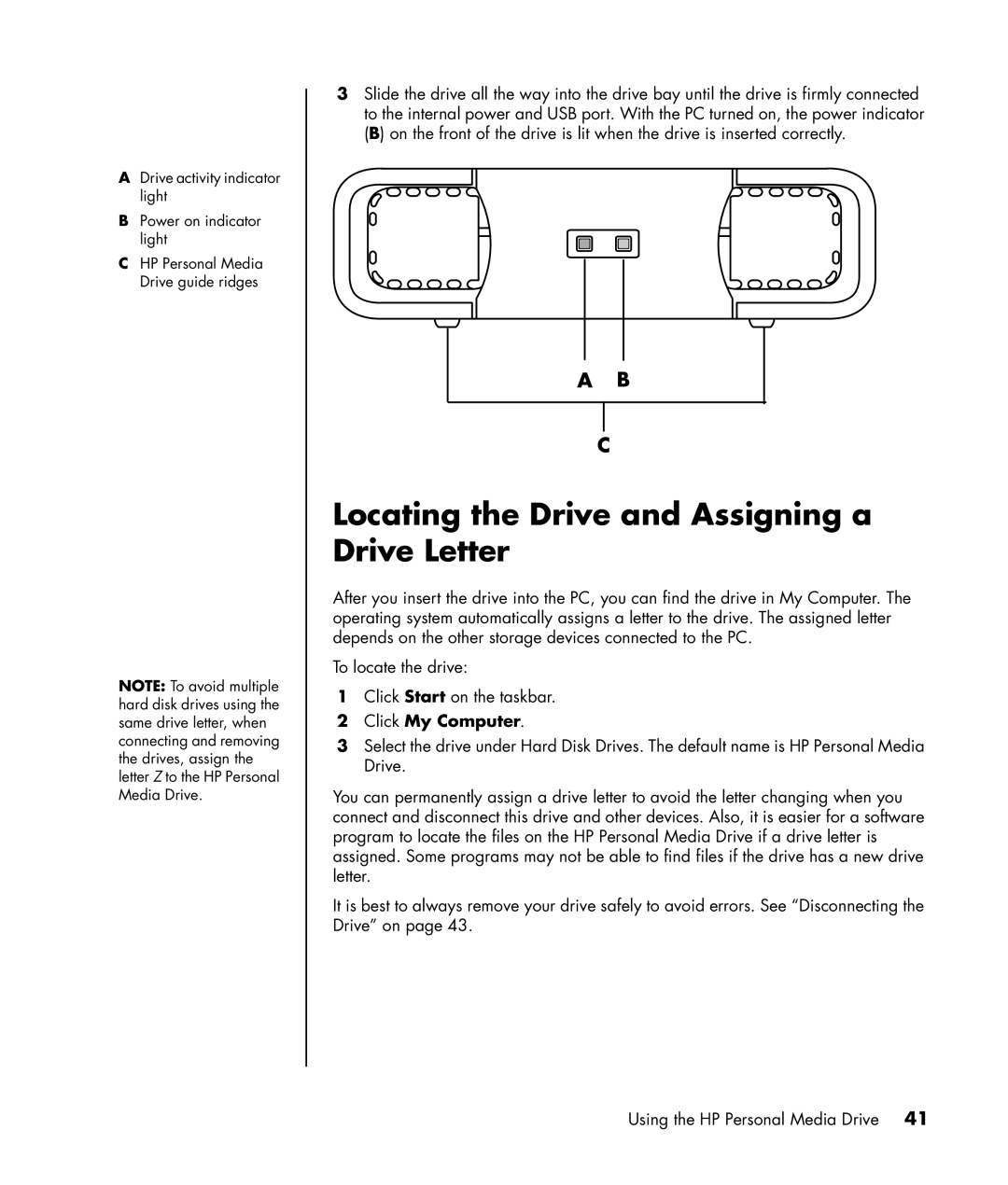Getting Started Guide
USA
Table of Contents
Working with Digital Images
Using the Memory Card Reader
Using a TV as a Monitor
Using the HP Personal Media Drive
Creating Video Discs and Movies
Creating Audio and Data Discs
Index
Creating Movies Using muvee autoProducer
Getting Help
Putting Your PC Together
Setting Up Your PC
Serial
Connecting to the PC
Connector Description Symbol Mouse PS/2 connector
Turning On Your PC for the First Time
Connector Description Symbol Audio Line Out powered speakers
Online Services, and then click Easy Internet Sign-up
Setting Up and Connecting to Your Internet Account
Using HP products
Installing Software and Hardware Devices
Choose All Programs
Using Desktop Icons
Using HP Organize software
Icon Opens Use it to
Hp or
Using the Keyboard
Icon Feature Description
DVD/MP3
Customizing the keyboard buttons
Getting Started Guide
Using Speakers
Setting Up Sound
Connect speaker plugs for To PC Connector Speaker Icon Mode
Setting up 3-connector sound
Click the Speaker Configuration tab
Configuring multi-channel audio output for the DVD player
Identifying the audio connectors 6-connector
Setting up 6-connector sound
Connect speaker cable plug for To PC port label, name Color
Configuring the Sound Effect Manager 6-connector
Click the Speaker Configuration button
Page
Sound Effect Manager control screens
Using the Sound Effect Manager 6-connector
To open the Sound Effect Manager
Retasking using the Audio Wizard 6-connector
To enable the Audio Wizard
Connector Name Icon Color
Using Your Docking Bay
Using Your PC Top
To store CDs, DVDs, or memory cards
Page
Using Your Multistorage Bay
Multistorage bay chassis figure
Storing CDs, DVDs, or memory cards
Docking a peripheral device
Placing a peripheral device on the multistorage bay top
Using the optional camera station PC top
Write Dvd Bay Exp Ansio
Writer & cd writer dvd hp Bay expansion
Removing cables from the multistorage bay cable tunnel
Card Slot reader
Using the Memory Card Reader
Working with the Safely Remove Hardware utility
Using the memory card reader
Card Insert Into 4-slot reader
Slot memory card reader
Card Insert Into 2-slot reader
CompactFlash I/II
Identifying Cables You May Need
Using a TV as a Monitor
Connecting to a TV Set
Viewing the PC Image on Your TV Screen
Click the Ge Force FX xxxx tab
NView tab
Ge Force tab
Displays tab
Disabling the TV Option
Displays tab disabling
NView tab disabling
Ge Force tab disabling
Disconnecting the TV
Connecting the Drive
Using the HP Personal Media Drive
Inserting the Drive
Click My Computer
Locating the Drive and Assigning a Drive Letter
Using the Drive
Disconnecting the Drive
Getting Started Guide
Working with Digital Images
Using HP Image Zone Plus
Working with Digital Images
Selection tray
Creating disc labels with HP Image Zone Plus
Burning a label on a LightScribe media disc
Click Print LightScribe label
Page
Getting Started Guide
Playing Music CDs with iTunes
Playing CDs and DVDs
Playing DVD Movies with InterVideo WinDVD
Playing CDs and DVDs with Windows Media Player
Page
Playing Video CDs VCD with InterVideo WinDVD
Using country/region codes
Playing Video CDs VCD with Windows Media Player
Getting Started Guide
Creating Audio and Data Discs
Working with Audio CDs
Erasing Rewritable Discs Before Recording
Audio CD tips
Verifying audio disc recorded without errors
Creating jukebox discs
Creating audio CDs
Working with Data DVDs and CDs
Verifying data disc recorded without errors
Creating data discs
Data disc tips
Copying a DVD or CD
Working with Image Files
Archiving Files on a CD or DVD
Burning from an image file
Disc Labeling with LightScribe
Creating an image file
Burning a LightScribe label with Sonic Express Labeler
LightScribe requirements
Burning a LightScribe label after burning with iTunes
Compatibility Information
Using adhesive disc labels
Layer
Disc Features and Compatibility Table
DVD-R
Double
Double-Layer Combo
Optical Drive Quick Reference Table
Optical drive can
With this program You can
Software Quick Reference Table
With this program You can
Before You Begin Capturing Video
Creating Video Discs and Movies
Creating a Video Project
Sonic MyDVD Video Projects
Click Add Files
Adding files to a video project
Capturing video to a video project
Adding submenus to a video project
Adding slide shows to a video project
To This Menu
Editing the style of a video project
Editing movie files
Click Edit Style
Burning a video project to disc
Creating a Video Project with Direct-to-Disc Wizard
Video Quality and Disc Size
Estimated Time per Disc Size Video Quality Audio Format
DVD Recording Time
Getting Started Guide
Basic Steps to Make a Movie
Creating Movies Using muvee autoProducer
Locating the muvee autoProducer
Getting started
Using muvee autoProducer
Save
Button Allows you to See Title
Credits
Make muvee
Click the Get Video from Camera button
Capturing video from a DV camcorder
Adding videos
Adding music
Adding pictures
Selecting the style
Changing the settings
Adding an opening title and closing credits
VCD video CD
Making the movie
Saving the movie project
Computer Playback Mail DV camcorder
Recording the movie project to disc
Upgrading muvee autoProducer
Getting Started Guide
Choose All Programs Choose Documentation
Getting Help
Finding Onscreen Guides
Finding Guides on the Web
Getting messages
Using the Onscreen Help and Support Center
Using Updates from HP
Choose All Programs Choose PC Help & Tools
Using PC Help & Tools
Turning off messages
Reactivating messages
Getting Started Guide
Index
Symbols
Audio discs 59 data discs 62 closed-session
FireWire 20, 23, 24, 25, 87 Fit to music
Getting Started Guide
Installing 5 software programs iTunes
Part Number Getting Started Guide

